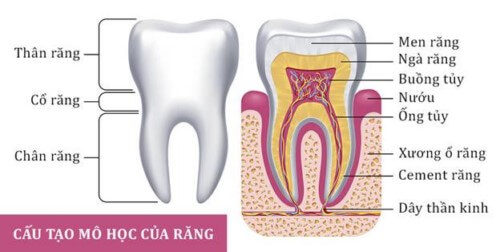ROOT CANAL TREATMENT AND THE 5 STEP ROOT CANAL PROCEDURE
What is tooth pulp?
Tooth pulp is a special connective tissue consisting of blood vessels and nerves located in the pulp cavity and surrounded by the hard tissues of the tooth (including enamel and dentin). The tooth pulp enters the tooth from the top of the root.

The pulp cavity is a cavity in the middle of the tooth. The cavity in the crown of the tooth is called the pulp chamber, and the pulp inside is called the pulp chamber. The cavity at the root of the tooth is called the root canal and the pulp inside is called the root canal. Each tooth root can have 1 or more root canals and many additional root canals. The root canals of a tooth are called the root canal system.
The tip of the tooth root, where blood vessels and nerves enter, is called the tooth tip (root).
Dental pulp participates in sensory functions, nourishes and repairs dentin.
Effects of dental pulp
- Dentin Formation: The tooth pulp responds to injuries in the hard tissues or participates in nourishing and repairing dentin.
- Nutritional Function: The pulp tissue contains a network of blood vessels that nourish the entire complex of pulp and dentin.
- Nervous Function: It transmits sensations and nerve impulses. It perceives and transmits sensations when there are stimuli affecting the tooth, including sensations of sensitivity, heat, cold, pain, and the sensation of applied force, such as trauma or dental caries.
- Protective Function: The protective function is carried out through two processes: dentin regeneration and immune response, which contribute to maintaining the vitality and health of the tooth.
What is root canal treatment?
When dental pulp inflammation occurs, it can have serious consequences for the patient’s quality of life. Individuals suffering from pulpitis may experience prolonged and severe pain if left untreated. This condition can lead to damage to other soft tissues or the surrounding teeth.
Root canal treatment is the term for the process of removing damaged tooth pulp from the root canal, then filling the root canal with specialized filling material and restoring the tooth’s shape.
In what cases do you need root canal treatment?
In some cases, when dental pulpitis causes pain for the patient but has the potential for recovery, the treating dentist will provide factors that enhance the remineralization process and prevent further mineral loss to restore the damaged pulp.
For cases where deep cavities have formed, and the tooth pulp is inflamed or necrotic, making recovery impossible, it is necessary to remove the entire pulp from the pulp chamber to end the patient’s prolonged discomfort and avoid potential harm to the tooth structure if the inflammation continues for an extended period.
In situations where a tooth has suffered a severe injury leading to cracks, exposed pulp, affecting aesthetics and chewing function.
Advantages and disadvantages of root canal treatment
Advantages of root canal treatment
Permanent root canal treatment will help restore injuries and damage to your teeth.
Completely treat the pain that makes you uncomfortable when you have pulpitis
Avoid the risks of abscesses, jaw bone loss or permanent tooth loss. Even more serious is causing blood infection and death.
Disadvantages of root canal treatment
After a root canal, the tooth will no longer have nourishing pulp. At this time, teeth will easily become discolored, not as durable as before, but will be more fragile and fragile.
If the marrow is not completely removed, it will lead to reinfection, seriously affecting the patient’s life.
Is root canal painful?

Nowadays, dental technology is becoming increasingly advanced and developed, which means that the process of tooth extraction is becoming gentler and shorter than before. For mild cases of pulpitis, tooth extraction is entirely painless. During treatment, patients may feel some numbness, but the discomfort is not severe. In cases of severe pulpitis, the pulp treatment process may cause the patient to experience pain and discomfort, but it can still be tolerated, as the pain during pulp treatment is less intense than the prolonged pain caused by pulp inflammation.
Root canal treatment process
Step 1: Examination and X-rays
First, the patient needs to visit the dental clinic for a general examination of the teeth and jaws, followed by taking X-rays to determine the extent of the tooth pulp inflammation, enabling the dentist to develop an appropriate treatment plan.
Step 2: Cleaning and Anesthesia
The dentist will perform a teeth cleaning procedure to remove any plaque or remaining food particles to ensure sterility. Subsequently, the dentist will administer local anesthesia to ensure the patient’s comfort during treatment.
Step 3: Rubber Dam Placement
At this point, the teeth are isolated entirely to prevent any solutions, medications, or fluids from entering the mouth or saliva, ensuring the patient’s safety and comfort throughout the procedure.
Step 4: Opening the Pulp Chamber and Pulp Removal
Next, the dentist will use specialized medical instruments to open the pulp chamber and remove the inflamed pulp from the root canal system.
Step 5: Shaping and Sealing the Root Canal
Once the inflamed pulp has been completely removed, and the patient is no longer experiencing pain, the dentist will begin sealing the root canal with specialized dental materials. After sealing, the dentist will restore the tooth’s structure using dental filling materials, ensuring the patient regains the chewing function of the tooth.
How long does root canal treatment take?
Depending on the severity of pulp inflammation, the dentist will schedule appointments with you. If the pulp inflammation is mild, an additional appointment may be set. However, in cases of severe and complex pulp inflammation, the dentist may need to schedule 2 to 3 additional treatment sessions before completing the pulp removal.
Instructions for care after root canal treatment
After a root canal treatment, the tooth may become more fragile and prone to breakage compared to when it had a healthy pulp. Therefore, after a root canal, you should limit the following foods:
- The food tastes too sour
- Food has hardness
- Do not drink drinks that are too hot or too cold
- Avoid using tobacco, coffee, and alcohol.
After a root canal treatment, the tooth is still at risk of recurring tooth decay. Because there is no longer a pulp to feel pain from tooth decay, it’s important to visit the dentist regularly for check-ups to monitor the condition of your teeth.
A reputable place for root canal treatment in Binh Duong
If you still can’t choose a reputable dental clinic to entrust with your trust, Nha Khoa Nụ Cười Duyên (Bình Dương) will be an excellent suggestion for you.
Throughout many years of operation, Nha Khoa Nụ Cười Duyên (Bình Dương) has treated many cases of prolonged pain caused by pulpitis for numerous customers. Therefore:
- We have a team of highly competent and specialized dentists in all areas of dentistry.
- We boast extensive experience in providing treatment, ensuring that our patients receive the best possible experience when they choose our services.
- Our dental clinic is equipped with state-of-the-art technology and equipment, which guarantees a seamless and professional treatment experience at Nha Khoa Nụ Cười Duyên.
- Our treatment costs are competitive, offering reasonable pricing. Moreover, we provide numerous benefits for our customers, along with regular customer appreciation programs.
Price list of root canal treatment services at Charm Smile Dental Clinic
| Permanent root canal treatment | 700.000 – 2.000.000 VNĐ/Tooth |
| Permanent root canal treatment (3-4 roots) | 1.500.000 – 3.000.000 VNĐ/Tooth |

